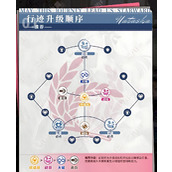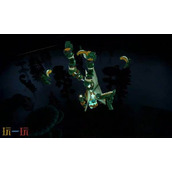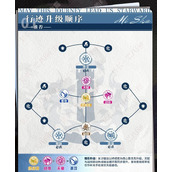DataGridView用法
需要指定新加行的默认值的时候,可以在datagridview.defaultvaluesneeded事件里处理。在该事件中处理除了可以设定默认值以外,还可以指定某些特定的单元格的readonly属性等。
// defaultvaluesneeded 事件处理方法
private void datagridview1_defaultvaluesneeded(object sender,
datagridviewroweventargs e)
{
// 设定单元格的默认值
e.row.cells["column1"].value = 0;
e.row.cells["column2"].value = "-";
}
datagridview获得焦点
dgv_details.focus();
datagridview指定当前单元格
dgv_details.currentcell = dgv_details[0, 0];
开始编辑状态
dgv_details.beginedit(false);
单元格颜色(前景色和背景色)
dgv.rows[0].cells[0].style.backcolor = color.darkorange;
dgv.rows[1].cells[0].style.forecolor = color.darkred;
datagridview中删除行主要代码:
private void btndelete_click(object sender, eventargs e)
{
//判断用户是否选择一行数据,true为没选择,false为选择
if (this.dgv.rows[this.dgv.currentrow.index].cells[0].value.tostring()=="")
{
messagebox.show("请选择一项进行删除");
}
else
{
//判断用户是否点击确定按钮,true为点击,false为没有点击
if (messagebox.show("确认删除?","提示", messageboxbuttons.yesno)==dialogresult.yes)
{
//定义数组,用循环赋值
string[] array = new string[];
for (int i = 0; i
{
string str = this.dgv.rows[this.dgv.selectedrows[i].index].cells[0].value.tostring();
string strdelete = "delete from students where studentnumber='" + str + "'";
array[i] = strdelete;
}
//遍历数组
foreach (string str in array)
{
this.update(str);
}
//这里写刷新的方法
}
}
}
列宽的调整
datagridview有一个属性是autosizecolumnmode,他有几个属性:
allcells 调整列宽,以适合该列中的所有单元格的内容,包括标题单元格。
allcellsexceptheader 调整列宽,以适合该列中的所有单元格的内容,不包括标题单元格。
columnheader 调整列宽,以适合列标题单元格的内容。
displayedcells 调整列宽,以适合当前屏幕上显示的行的列中的所有单元格的内容,包括标题单元格。
displayedcellsexceptheader 调整列宽,以适合当前屏幕上显示的行的列中的所有单元格的内容,不包括标题单元格。
fill 调整列宽,使所有列的宽度正好填充控件的显示区域,只需要水平滚动保证列宽在 datagridviewcolumn.minimumwidth 属性值以上。相对列宽由相对 datagridviewcolumn.fillweight 属性值决定。
none 列宽不会自动调整。
notset 列的大小调整行为从 datagridview.autosizecolumnsmode 属性继承。
设置为fill.
然后先给datagridview绑定数据源.然后
dataset ds2 = momedal.binddvg(flagcbb);
this.dgvmain.datasource = ds2.tables[0];
this.dgvmain.columns[0].fillweight = 8; //第一列的相对宽度为8%
this.dgvmain.columns[1].fillweight = 22; //第一列的相对宽度为22%
this.dgvmain.columns[2].fillweight = 70; //第一列的相对宽度为70%
设置标题字段(先把columnsheadersvisible设置为true)
this.dgvmain.columns[0].headertext = "编号";
this.dgvmain.columns[1].headertext = "日期";
this.dgvmain.columns[2].headertext = "标题";
颜色设置,相隔行颜色不同
public void setdatagridcolor(int ncount)
{
for (int i = 0; i
{
this.datagridview1.rows[i].defaultcellstyle.backcolor = system.drawing.color.lightgray;
i += 2;
}
}
在cellmouseclick里操作,添加右键菜单
private void datagridview_cellmouseclick(object sender, datagridviewcellmouseeventargs e)
{
if (e.button == mousebuttons.right)
{
if (e.rowindex >= 0)
{
datagridview1.clearselection();
datagridview1.rows[e.rowindex].selected = true; //选中
datagridview1.currentcell = datagridview1.rows[e.rowindex].cells[e.columnindex];//选中单元
datagridrightmenu.show(mouseposition.x, mouseposition.y); //在点击处显示右键菜单
}
}
}
冻结
列冻结
datagridviewcolumn.frozen 属性为 true 时, 该列左侧的所有列被固定, 横向滚动时固定列不随滚动条滚动而左右移动。这对于重要列固定显示很有用。
[c#]
// datagridview1的左侧2列固定
datagridview1.columns[1].frozen = true;
但是,datagridview.allowusertoordercolumns = true 时,固定列不能移动到非固定列, 反之亦然。
行冻结
datagridviewrow.frozen 属性为 true 时, 该行上面的所有行被固定, 纵向滚动时固定行不随滚动条滚动而上下移动。
[c#]
// datagridview1 的上3行固定
datagridview1.rows[2].frozen = true;
datagridview 列顺序的调整
设定 datagridview 的 allowusertoordercolumns 为 true 的时候, 用户可以自由调整列的顺序。
当用户改变列的顺序的时候,其本身的 index 不会改变,但是 displayindex 改变了。你也可以通过程序改变 displayindex 来改变列的顺序。 列顺序发生改变时会引发 columndisplayindexchanged 事件:
[c#]
// datagridview1的columndisplayindexchanged事件处理方法
private void datagridview1_columndisplayindexchanged(object sender,
datagridviewcolumneventargs e)
{
console.writeline("{0} 的位置改变到 {1} ",
e.column.name, e.column.displayindex);
}
datagridview 行头列头的单元格
[c#]
// 改变datagridview1的第一列列头内容
datagridview1.columns[0].headercell.value = "第一列";
// 改变datagridview1的第一行行头内容
datagridview1.rows[0].headercell.value = "第一行";
// 改变datagridview1的左上头部单元内容
datagridview1.topleftheadercell.value = "左上";
另外你也可以通过 headertext 来改变他们的内容。
[c#]
// 改变datagridview1的第一列列头内容
datagridview1.columns[0].headertext = "第一列";
定义单元格验证
要求:验证错误后焦点不离开。
实现:
单元格的验证可以使用dgv_details_cellvalidating事件。
验证不通过时调用e.cancel = true;终止事件链,单元格将保持编辑状态。
调用dgv_details.canceledit();可以使单元格的内容会滚到修改前的值。
使用system.windows.forms.sendkeys.send("^a");将全选单元格的内容。
设置列的背景色
实现:
color gridreadonlycolor = color.lightgoldenrodyellow;
dgv_details.columns[1].defaultcellstyle.backcolor = ((winkeys.))gridreadonlycolor;
datagridview合并单元格 编辑单元格
同事的一个项目需要将datagridview单元格中的内容分不同颜色显示,想了想只有重绘了。
这种方法还可以用做合并单元格。
参考代码:
view code
private void datagridview1_cellpainting(object sender, datagridviewcellpaintingeventargs e)
{
if (e.rowindex == 0 && e.columnindex >= 0)
{
int left = e.cellbounds.left;
int top = e.cellbounds.top;
int right = e.cellbounds.right;
int bottom = e.cellbounds.bottom;
e.graphics.fillrectangle(new solidbrush(color.white), e.cellbounds);
e.handled = true;
brush gridbrush = new solidbrush(this.datagridview1.gridcolor);
pen gridlinepen = new pen(gridbrush);
e.graphics.drawline(gridlinepen, right - 1,
top, right - 1,
bottom - 1);
e.graphics.drawline(gridlinepen, left,
bottom - 1, right,
bottom - 1);
brush b1 = new solidbrush(color.black);
e.graphics.drawstring((string)e.value, e.cellstyle.font,
b1, left + 2,
top + 1, stringformat.genericdefault);
brush b2 = new solidbrush(color.red);
e.graphics.drawstring((string)e.value, e.cellstyle.font,
b2, left + 2,
top + 10, stringformat.genericdefault);
}
datagridviewselectedcellcollection dgvscc = this.datagridview1.selectedcells;
foreach (datagridviewcell dgvc in dgvscc)
{
if (e.rowindex == 0
&& e.rowindex == dgvc.rowindex
&& e.columnindex == dgvc.columnindex)
{
int left = e.cellbounds.left;
int top = e.cellbounds.top;
int right = e.cellbounds.right;
int bottom = e.cellbounds.bottom;
// 绘制背景,覆盖单元格区域
e.graphics.fillrectangle(new solidbrush(color.fromargb(10,36,106)), e.cellbounds);
// 绘制边框
brush gridbrush = new solidbrush(this.datagridview1.gridcolor);
pen gridlinepen = new pen(gridbrush);
e.graphics.drawline(gridlinepen, right - 1,
top, right - 1,
bottom - 1);
e.graphics.drawline(gridlinepen, left,
bottom - 1, right,
bottom - 1);
// 绘制文字
brush b1 = new solidbrush(color.white);
e.graphics.drawstring((string)e.value, e.cellstyle.font,
b1, left + 2,
top + 1, stringformat.genericdefault);
brush b2 = new solidbrush(color.white);
e.graphics.drawstring((string)e.value, e.cellstyle.font,
b2, left + 2,
top + 10, stringformat.genericdefault);
}
}
e.handled = true;
}
cellpainting事件,一般用于合并单元格用
windows forms datagridview 没有提供合并单元格的功能,要实现合并单元格的功能就要在cellpainting事件中使用graphics.drawline和 graphics.drawstring 自己来“画”。
下面的代码可以对datagridview第1列内容相同的单元格进行合并:
view code
#region"合并单元格的测试"
private int? nextrow = null;
private int? nextcol = null;
private void datagridview1_cellformatting(object sender, system.windows.forms.datagridviewcellformattingeventargs e)
{
if (this.datagridview1.columns["description"].index == e.columnindex && e.rowindex >= 0)
{
if (this.nextcol != null & e.columnindex == this.nextcol)
{
e.cellstyle.backcolor = color.lightblue;
this.nextcol = null;
}
if (this.nextrow != null & e.rowindex == nextrow)
{
e.cellstyle.backcolor = color.lightpink;
this.nextrow = null;
}
if (e.rowindex != this.datagridview1.rowcount - 1)
{
if (e.value.tostring() == this.datagridview1.rows[e.rowindex + 1].cells[e.columnindex].value.tostring())
{
e.cellstyle.backcolor = color.lightpink;
nextrow = e.rowindex + 1;
}
}
}
if (this.datagridview1.columns["name"].index == e.columnindex && e.rowindex >= 0)
{
if (e.value.tostring() == this.datagridview1.rows[e.rowindex].cells[e.columnindex + 1].value.tostring())
{
e.cellstyle.backcolor = color.lightblue;
nextcol = e.columnindex + 1;
}
}
}
//==========================
//绘制单元格
private void datagridview1_cellpainting(object sender, system.windows.forms.datagridviewcellpaintingeventargs e)
{
//纵向合并
if (this.datagridview1.columns["description"].index == e.columnindex && e.rowindex >= 0)
{
using (
brush gridbrush = new solidbrush(this.datagridview1.gridcolor),
backcolorbrush = new solidbrush(e.cellstyle.backcolor))
{
using (pen gridlinepen = new pen(gridbrush))
{
// 擦除原单元格背景
e.graphics.fillrectangle(backcolorbrush, e.cellbounds);
////绘制线条,这些线条是单元格相互间隔的区分线条,
////因为我们只对列name做处理,所以datagridview自己会处理左侧和上边缘的线条
if (e.rowindex != this.datagridview1.rowcount - 1)
{
if (e.value.tostring() != this.datagridview1.rows[e.rowindex + 1].cells[e.columnindex].value.tostring())
{
e.graphics.drawline(gridlinepen, e.cellbounds.left, e.cellbounds.bottom - 1,
e.cellbounds.right - 1, e.cellbounds.bottom - 1);//下边缘的线
//绘制值
if (e.value != null)
{
e.graphics.drawstring((string)e.value, e.cellstyle.font,
brushes.crimson, e.cellbounds.x + 2,
e.cellbounds.y + 2, stringformat.genericdefault);
}
}
}
else
{
e.graphics.drawline(gridlinepen, e.cellbounds.left, e.cellbounds.bottom - 1,
e.cellbounds.right - 1, e.cellbounds.bottom - 1);//下边缘的线
//绘制值
if (e.value != null)
{
e.graphics.drawstring((string)e.value, e.cellstyle.font,
brushes.crimson, e.cellbounds.x + 2,
e.cellbounds.y + 2, stringformat.genericdefault);
}
}
//右侧的线
e.graphics.drawline(gridlinepen, e.cellbounds.right - 1,
e.cellbounds.top, e.cellbounds.right - 1,
e.cellbounds.bottom - 1);
e.handled = true;
}
}
}
//横向合并
if (this.datagridview1.columns["name"].index == e.columnindex && e.rowindex >= 0)
{
using (
brush gridbrush = new solidbrush(this.datagridview1.gridcolor),
backcolorbrush = new solidbrush(e.cellstyle.backcolor))
{
using (pen gridlinepen = new pen(gridbrush))
{
// 擦除原单元格背景
e.graphics.fillrectangle(backcolorbrush, e.cellbounds);
if (e.value.tostring() != this.datagridview1.rows[e.rowindex].cells[e.columnindex + 1].value.tostring())
{
//右侧的线
e.graphics.drawline(gridlinepen, e.cellbounds.right - 1, e.cellbounds.top,
e.cellbounds.right - 1, e.cellbounds.bottom - 1);
//绘制值
if (e.value != null)
{
e.graphics.drawstring((string)e.value, e.cellstyle.font,
brushes.crimson, e.cellbounds.x + 2,
e.cellbounds.y + 2, stringformat.genericdefault);
}
}
//下边缘的线
e.graphics.drawline(gridlinepen, e.cellbounds.left, e.cellbounds.bottom - 1,
e.cellbounds.right - 1, e.cellbounds.bottom - 1);
e.handled = true;
}
}
}
}
#endregion
cellformatting事件,一般重绘单元格属性。
view code
private bitmap highpriimage;
private bitmap mediumpriimage;
private bitmap lowpriimage;
private void datagridview1_cellformatting(object sender,
system.windows.forms.datagridviewcellformattingeventargs e)
{
// set the background to red for negative values in the balance column.
if (datagridview1.columns[e.columnindex].name.equals("balance"))
{
int32 intvalue;
if (int32.tryparse((string)e.value, out intvalue) &&
(intvalue
{
e.cellstyle.backcolor = color.red;
e.cellstyle.selectionbackcolor = color.darkred;
}
}
// replace string values in the priority column with images.
if (datagridview1.columns[e.columnindex].name.equals("priority"))
{
// ensure that the value is a string.
string stringvalue = e.value as string;
if (stringvalue == null) return;
// set the cell tooltip to the text value.
datagridviewcell cell = datagridview1[e.columnindex, e.rowindex];
cell.tooltiptext = stringvalue;
// replace the string value with the image value.
switch (stringvalue)
{
case "high":
e.value = highpriimage;
break;
case "medium":
e.value = mediumpriimage;
break;
case "low":
e.value = lowpriimage;
break;
}
}
}
在dgv中加入控件列
view code
using system;
using system.collections;
using system.componentmodel;
using system.data;
using system.data.sqlclient;
using system.drawing;
using system.web;
using system.web.sessionstate;
using system.web.ui;
using system.web.ui.webcontrols;
using system.web.ui.htmlcontrols;
namespace csdn
{
///
/// webform30 的摘要说明。
///
public class webform30 : system.web.ui.page
{
datagrid datagrid1=new datagrid();
private void page_load(object sender, system.eventargs e)
{
// 在此处放置用户代码以初始化页面
createdatagrid();
}
protected void createdatagrid()
{
datagrid1.autogeneratecolumns=false;
datagrid1.css教程class="border";
datagrid1.border;
datagrid1.cellspacing=1;
datagrid1.cellpadding=5;
datagrid1.itemstyle.cssclass="item";
datagrid1.headerstyle.cssclass="header";
datagrid1.datakeyfield="stuid";
//以上设定datagrid的样式
templatecolumn tm=new templatecolumn();
tm.itemtemplate=new columntemplate1();
tm.headertext="姓名";
datagrid1.columns.add(tm);
//建立第一个模板列
templatecolumn tm2=new templatecolumn();
tm2.itemtemplate=new columntemplate2();
tm2.headertext="学院";
datagrid1.columns.add(tm2);
//建立第二个模板列
buttoncolumn bc=new buttoncolumn();
bc.buttontype=buttoncolumntype.pushbutton;
bc.commandname="del";
bc.text="删除";
datagrid1.columns.add(bc);
//建立删除按钮列
setbind();
//填充数据
page.controls[1].controls.add(datagrid1);
//给页面的form加入这个datagrid1
}
protected void setbind()
{
sqlconnection conn=new sqlconnection(system.configuration.configurationsettings.apps教程ettings["conn"]);
sqldataadapter da=new sqldataadapter("select * from stu,dep where stu.studepid=dep.depid",conn);
dataset ds=new dataset();
da.fill(ds,"table1");
this.datagrid1.datasource=ds.tables["table1"];
this.datagrid1.databind();
}
private void datagrid1_itemdatabound(object sender, system.web.ui.webcontrols.datagriditemeventargs e)
{
//和上面连接给出的例子中的代码一样,给下拉框绑定数据,并且选择默认的
sqlconnection conn=new sqlconnection(system.configuration.configurationsettings.appsettings["conn"]);
sqldataadapter da=new sqldataadapter("select * from dep",conn);
dataset ds=new dataset();
da.fill(ds,"table1");
if(e.item.itemtype==listitemtype.item||e.item.itemtype==listitemtype.alternatingitem)
{
dropdownlist ddl=(dropdownlist)e.item.findcontrol("dep");
ddl.datasource=ds.tables["table1"];
ddl.datatextfield="depname";
ddl.datavaluefield="depid";
ddl.databind();
ddl.items.findbyvalue(convert.tostring(databinder.eval(e.item.dataitem,"depid"))).selected=true;
}
}
private void datagrid1_itemcommand(object source, system.web.ui.webcontrols.datagridcommandeventargs e)
{
if(e.commandname=="del")
{
sqlconnection conn=new sqlconnection(system.configuration.configurationsettings.appsettings["conn"]);
sqlcommand comm=new sqlcommand("delete from stu where );
sqlparameter parm1=new sqlparameter("@id",sqldbtype.int);
parm1.value=this.datagrid1.datakeys[e.item.itemindex];
comm.parameters.add(parm1);
conn.open();
comm.executenonquery();
conn.close();
setbind();
}
}
#region web 窗体设计器生成的代码
override protected void oninit(eventargs e)
{
//
// codegen: 该调用是 asp教程.net web 窗体设计器所必需的。
//
initializecomponent();
base.oninit(e);
}
///
/// 设计器支持所需的方法 - 不要使用代码编辑器修改
/// 此方法的内容。
///
private void initializecomponent()
{
this.load += new system.eventhandler(this.page_load);
this.datagrid1.itemdatabound += new system.web.ui.webcontrols.datagriditemeventhandler(this.datagrid1_itemdatabound);
this.datagrid1.itemcommand += new system.web.ui.webcontrols.datagridcommandeventhandler(this.datagrid1_itemcommand);//这里的两个事件千万别忘记,因为datagrid是后台创建的,这些事件需要自己来写上,vs.net也不会为你创建
}
#endregion
}
public class columntemplate1 : itemplate
{
//第一个模板列
public void instantiatein(control container)
{
literalcontrol l = new literalcontrol();
l.databinding += new eventhandler(this.ondatabinding);
//数据绑定
container.controls.add(l);
//为模板列加入literalcontrol
}
public void ondatabinding(object sender, eventargs e)
{
literalcontrol l = (literalcontrol) sender;//literalcontrol发送绑定请求
datagriditem container = (datagriditem) l.namingcontainer;
l.text = ((datarowview)container.dataitem)["stuname"].tostring();//绑定stuname字段
}
}
public class columntemplate2 : itemplate
{
//第二个模板列
public void instantiatein(control container)
{
dropdownlist dpl = new dropdownlist();
dpl.id="dep";
container.controls.add(dpl);
//加入一个id="dep"的下拉框,数据在datagrid的itemdatabound中绑定
}
}
}
datagridviewcheckboxcolumn 类
view code
private void addoutofofficecolumn()
{
datagridviewcheckboxcolumn column = new datagridviewcheckboxcolumn();
{
column.headertext = columnname.outofoffice.tostring();
column.name = columnname.outofoffice.tostring();
column.autosizemode =
datagridviewautosizecolumnmode.displayedcells;
column.flatstyle = flatstyle.standard;
column.threestate = true;
column.celltemplate = new datagridviewcheckboxcell();
column.celltemplate.style.backcolor = color.beige;
}
datagridview1.columns.insert(0, column);
}
datagridview 的单元格的边框、 网格线样式的设定
1) datagridview 的边框线样式的设定
datagridview 的边框线的样式是通过 datagridview.borderstyle 属性来设定的。 borderstyle 属性设定值是一个
borderstyle 枚举: fixedsingle(单线,默认)、fixed3d、none。
2) 单元格的边框线样式的设定
单元格的边框线的样式是通过 datagridview.cellborderstyle 属性来设定的。 cellborderstyle 属性设定值是
datagridviewcellborderstyle 枚举。(详细参见 msdn)
另外,通过 datagridview.columnheadersborderstyle 和 rowheadersborderstyle 属性可以修改 datagridview 的头部的单元格边框线样式。 属性设定值是 datagridviewheaderborderstyle 枚举。(详细参见 msdn)
3) 单元格的边框颜色的设定
单元格的边框线的颜色可以通过 datagridview.gridcolor 属性来设定的。默认是 controldarkdark 。但是只有在 cellborderstyle 被设定为 single、singlehorizontal、singlevertical 的条件下才能改变其边框线的颜色。同样,columnheadersborderstyle 以及 rowheadersborderstyle 只有在被设定为 single 时,才能改变颜色。
4) 单元格的上下左右的边框线式样的单独设定
cellborderstyle只能设定单元格全部边框线的式样。要单独改变单元格某一边边框式样的话,需要用到datagridview.advancedcellborderstyle属性。如示例:
同样,设定行头单元格的属性是: advancedrowheadersborderstyle, 设定列头单元格属性是:advancedcolumnheadersborderstyle。
datagridview 单元格表示值的自定义
通过cellformatting事件,可以自定义单元格的表示值。(比如:值为error的时候,单元格被设定为红色)
下面的示例:将“colmn1”列的值改为大写。
view code
[c#]
//cellformatting 事件处理方法
private void datagridview1_cellformatting(object sender,
datagridviewcellformattingeventargs e)
{
datagridview dgv = (datagridview)sender;
// 如果单元格是“column1”列的单元格
if (dgv.columns[e.columnindex].name == "column1" && e.value is string)
{
// 将单元格值改为大写
string str = e.value.tostring();
e.value = str.toupper();
// 应用该format,format完毕。
e.formattingapplied = true;
}
}
相关文章
精彩推荐
-
 下载
下载摩托车销售模拟器内置菜单中文版
模拟经营 摩托车销售模拟器内置菜单中文版摩托车出售模拟器,又名摩托车销售模拟器,这是一个以摩托车销售
-
 下载
下载船舶模拟2020最新版
模拟经营 船舶模拟2020最新版船舶模拟2020是玩法非常有意思的模拟驾驶游戏,高清3d画质
-
 下载
下载油管主播的生活2内置菜单版
模拟经营 油管主播的生活2内置菜单版油管主播的生活2内置菜单版是一款模拟养成类游戏,在这里你将体
-
 下载
下载网吧老板模拟器2手机版
模拟经营 网吧老板模拟器2手机版网吧老板模拟器2是非常受欢迎的模拟经营题材手游,在原本的基础
-
 下载
下载美国警察模拟器巡警2024最新版
模拟经营 美国警察模拟器巡警2024最新版美国警察模拟器是一款好玩的模拟手游,游戏中你将扮演一位警察,















